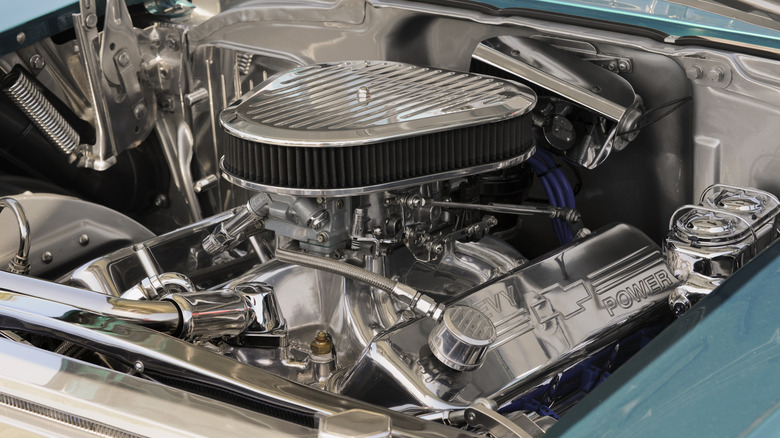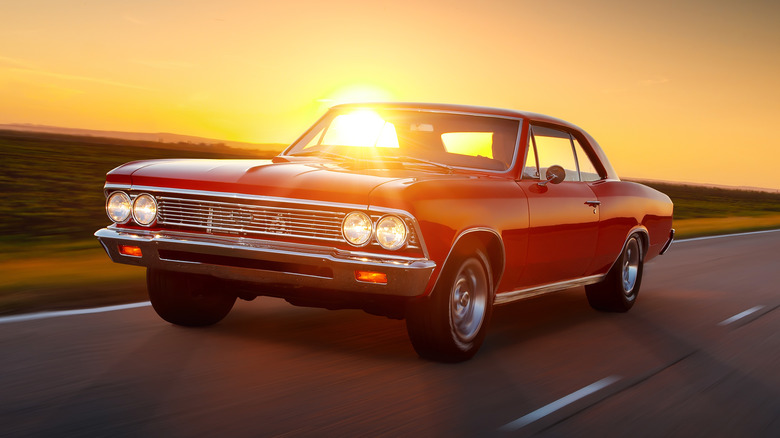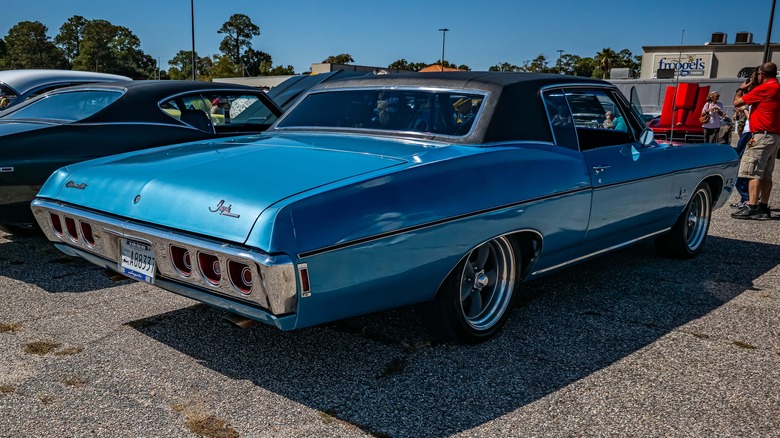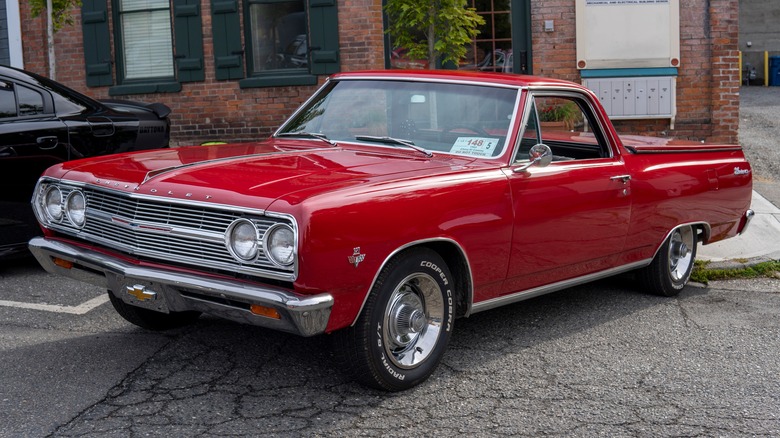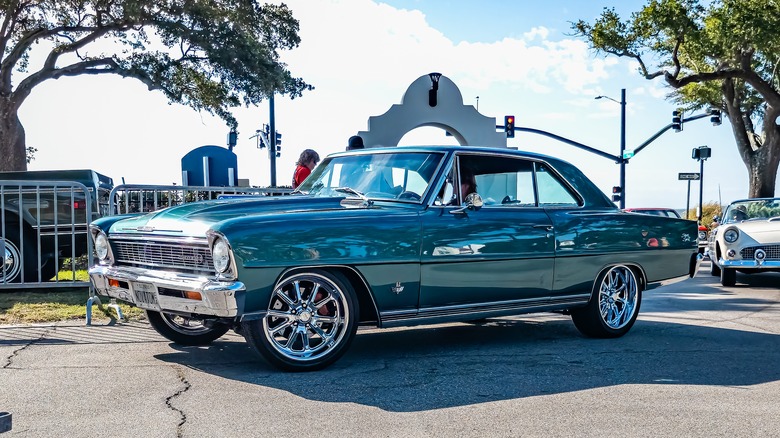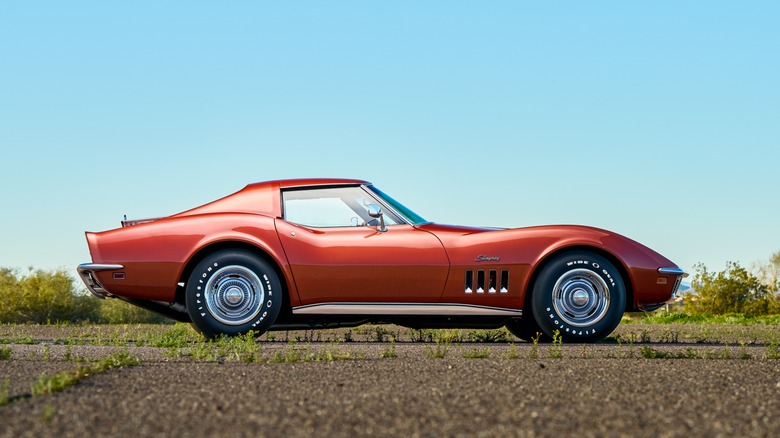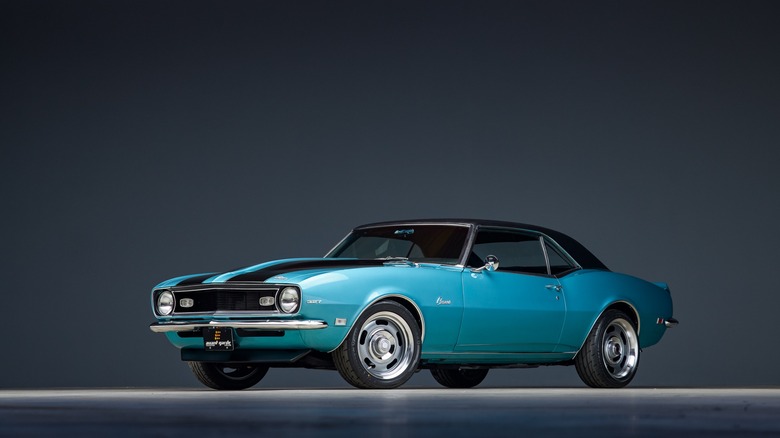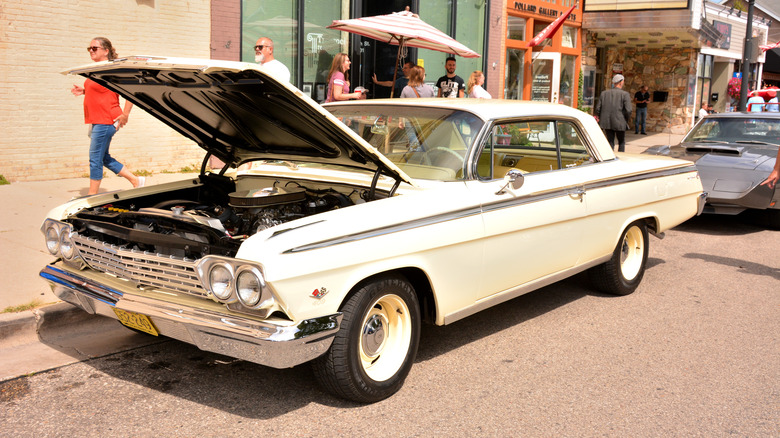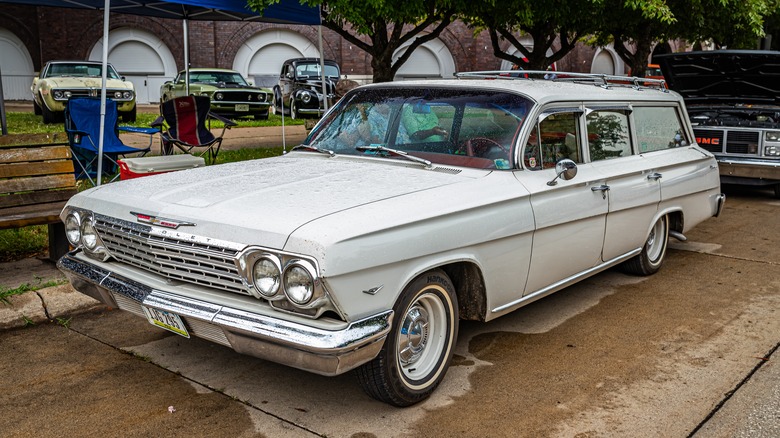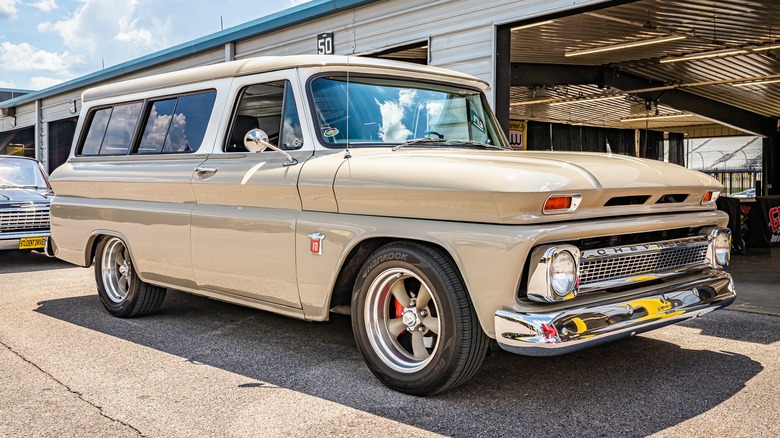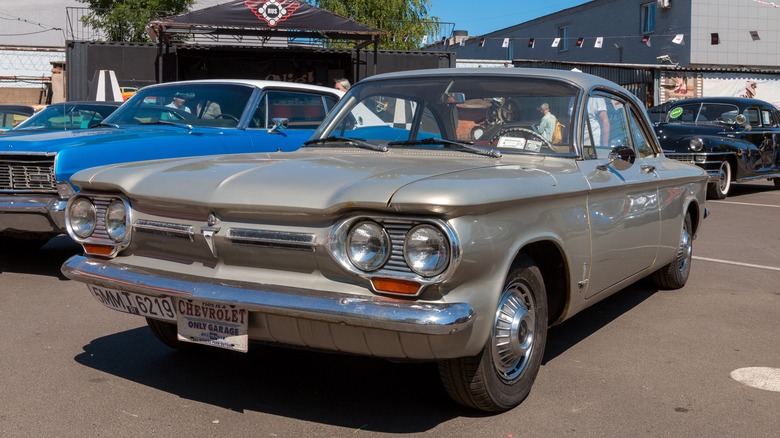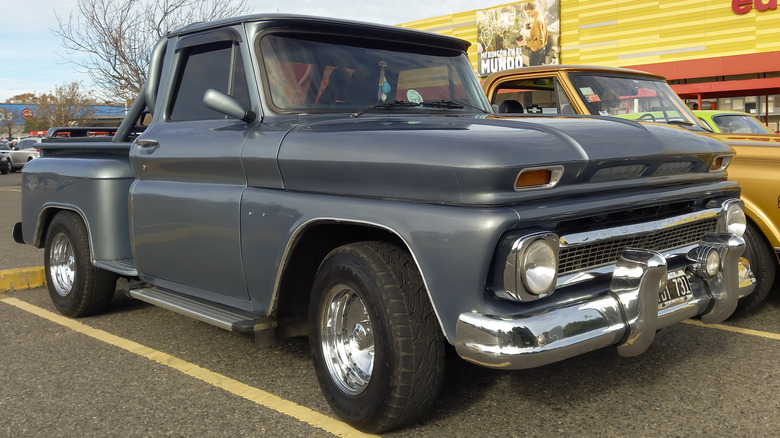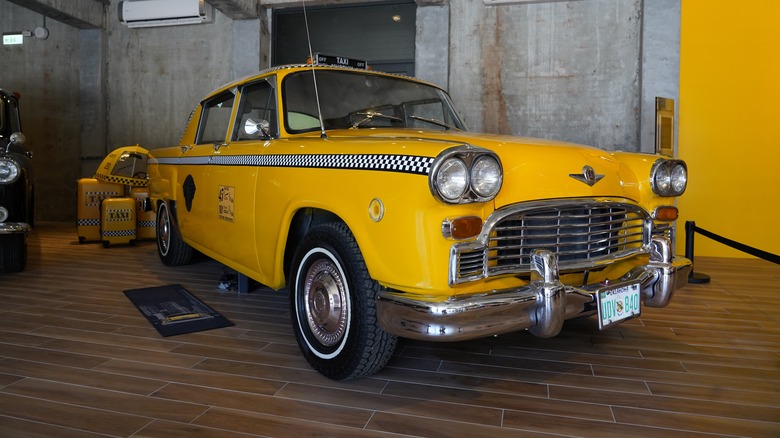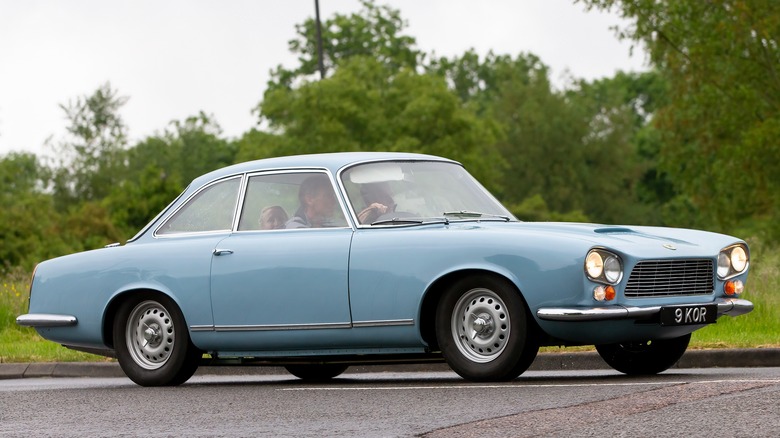Every Car Powered By The Chevy 327 V8 Engine
The Chevy 327 small block V8 is one of the most iconic engines in Chevy's history. Commonly referred to as Mighty Mouse, the 327-cubic inch V8 has several variants, including the L76 and L79 that Chevy used for the Chevy Corvette in the 1960s. At its worst, the 327 was capable of 210 horsepower and ranged all the way up to 365 horsepower and 350 lb.-ft of torque. The wide range of variants was because of one simple, inarguable fact — Chevy put this engine in nearly everything it produced with wheels during the engine's manufacturing run from 1962 to 1969.
That is not hyperbole. By our count, there were only three Chevy nameplates that existed between 1962 and 1969 that didn't have the 327 at least once. Those are the Chevy Astro race car prototypes that Chevy made back then, the short-lived Chevy Greenbrier van, and the Chevy G10 van, which never saw anything greater than a 307 cubic inch V8. You can bet that the 327 V8 was shoved into every other nameplate Chevy had at least once and a couple of cars that weren't even from Chevy.
Chevy Chevelle Malibu
The Chevy Chevelle Malibu SS was an important car in Chevy's lineup in the 1960s. It represented Chevy's midsize offering at the time and the American public was quite smitten with midsize cars in the mid-1960s. The Chevelle fit right between larger vehicles like the Bel Air and Impala and smaller vehicles like the Chevy II and Corvair. At the time, the Malibu nameplate was actually a trim level on the Chevy Chevelle and eventually became its own car in the late 1970s. This means that when you hear enthusiasts say that Chevy put the 327 in a Malibu, they're actually talking about the Malibu trim of the Chevelle car.
Chevelles equipped with the 327 are often referred to by enthusiasts as a Chevelle Malibu 327, so it's fairly easy to tell which ones have the 327 V8 and which ones don't. Initially, the 327 in the Chevelle Malibu was rated at 300 horsepower, but Chevy bumped it up to 350 horsepower after just one year. Most of the rest of the Chevelle lineup made do with a host of other engine options, including two six-cylinder engines and up to seven other V8s aside from the legendary 327 V8.
Chevy Impala and Caprice
The Chevy Impala was one of Chevy's larger cars in the 1960s and, as a fullsize vehicle, also came with the 327 V8 as an optional engine. Despite all of that firepower, the Impala was actually a pretty slow car, covering zero to 60 MPH in nine seconds and the quarter mile in 17.1 seconds. The primary reason is because this car was heavy at nearly 4,000 pounds. Like most of Chevy's cars back then, there were myriad other engine options as well. All told, Chevy equipped the Chevy Impala with at least seven different V8 engines across the 1960s.
Chevy would eventually come out with the Caprice to top the Impala as the de facto top-of-the-line full-size car starting in the 1966 model year after spending a year as a trim option on the Impala. The two were very similar but the Caprice had enough differences to be its own car. It featured a more rigid frame, acoustic treatment for a quieter interior, exterior styling differences, and a softer suspension for a smoother ride. The Caprice came with a 283 cubic-inch V8 stock but one of the optional engines was the Chevy 327.
Chevy El Camino
Ah yes, the Chevy El Camino. Loved by some, hated by others, the truck-car hybrid was one of Chevy's most unique models and has been spotted in movies and TV shows for decades. As a Chevy vehicle from the 1960s, the El Camino came with a few different engine options. They included a tamer 283 cubic-inch V8 that created 195 ponies, a 396 cubic-inch V8 that was much more powerful at up to 375 horsepower and, finally, one of the more powerful Chevy 327s at 350 horsepower. That puts the El Camino on the long, long list of Chevy cars with the 327.
Originally, the El Camino was designed to compete with the Ford Ranchero, which was one of Ford's most unique looking trucks. As the stories go, these trucks were designed to be powerful enough to do work but nice enough to drive to social events like church without looking bad. For the El Camino, the Chevy 327 was used in the first generation of the car and when Chevy redesigned the car for the second generation in 1968, the 327 was one of the eight engine configurations available for it as well.
Chevy II / Nova
The Chevy II and Nova have an interesting history. Chevy started making the Chevy II in 1962. The Nova was a trim level on the Chevy II. Eventually, Chevy started minimizing the Chevy II name and highlighting the Nova moniker. In 1969, Chevy dropped the II altogether and it became the Chevy Nova. As with most Chevy vehicles from that era, the Chevy II Nova definitely came with a 327 during its run, although it was a bit later to the party and didn't get the 327 as an optional engine until 1965.
Chevy kept the 327 as an optional engine through the 1968 model year, so you can find it on the spec sheet for Chevy II Novas from 1965 to 1968. However, in 1969, Chevy dropped the II moniker and also the 327 from the Nova. It still had well over half a dozen other engine options, so the 327 wasn't missed. So, technically speaking, the Chevy Nova never had the 327 but when it was part of the Chevy II nameplate, it did. We're going to count it — but we get it if you don't.
Chevy Corvette
Not only did Chevy Corvettes of the 1960s house the Chevy 327 V8 but they also had some of the most powerful variants of the engine that were available at the time. In fact, the Corvette used the L76 and L84 variants of the 327 V8, which were exclusive to Corvettes. Despite the naming conventions, the L76 wasn't far off from the L84. It put out 365 horsepower and 350 lb.-ft of torque while the L84 variant bumped that up to 375 horsepower. As such, these were some of the fastest and most powerful 327s on the market.
With the 350 horsepower variant of the 327, the 1965 Corvette went from zero to 60 MPH in just 5.6 seconds and cleared the quarter mile in 14.3 seconds. It doesn't seem that fast by today's standards but a sub six second zero to 60 MPH time was considered quite fast in the 1960s. Later, Chevy would put in larger engines that made the Corvette even faster. However, few scoffed at the power provided by the 327 V8. Chevy would stop using the 327 in the Corvette by 1969, instead letting buyers choose between four 427 cubic-inch V8 options or a 350 cubic-inch V8.
Chevy Camaro
The Chevy Camaro became the new kid on the block in the 1960s when Chevy released the first one in 1966. It was born from design elements first seen in the Chevy II Nova and then modified to be its own thing. It followed Ford's example almost perfectly, as the first Ford Mustang in 1964 was essentially a souped-up Ford Falcon. Chevy released the Chevy II to compete with the Falcon and then souped it up to create the Chevy Camaro. The two became natural rivals, especially with the powerful engines that Chevy was putting in its cars at the time.
Like the rest of Chevy's lineup, Chevy popped the 327 V8 into this car in 1966, 1967, and 1968. By 1969, Chevy had replaced it with a 307 cubic-inch V8 and two 427 cubic-inch V8s as engine options. Unlike the Corvette, which housed one of the most powerful variants of the 327 V8, the Camaro was actually on the tamer end of the spectrum. In 1966, '67, and '68, the 327 V8 in the Camaro only put out 210 horsepower. Eventually, there was an option for a 275 horsepower 327 V8 variant, but you needed a bigger engine for a faster Camaro.
Chevy Bel Air
We return to one of Chevy's famous boat cars for our next item on this list, which is the Chevy Bel Air. The sport coupe model of the Bel Air was somewhat well-known as being a decent little race car and Chevy's liberal touch with its engine options gave potential owners plenty of options as to how powerful the Bel Air could be. All told, there seven engine options for the Chevy Bel Air in 1966 alone, including one inline-six and six V8 engines. Among those were not one, but two 327 V8 options. The first was a 220 horsepower variant and the other was a 275 horsepower variant.
The Bel Air was special for a variety of reasons but among them was its usage of the 327 V8. It was one of the earliest models with the engine with it being an option for the 1963 model year. Consequently, it was also one of the last cars to come with the 327 as an option in 1969. By that point, most of Chevy's lineup had moved on to other, newer V8s. Chevy also made sure this was an engine option on all variants of the Bel Air, including the station wagon.
Chevy Biscayne
The Chevy Biscayne was in an odd spot in Chevy's lineup. It was among Chevy's cheapest offerings and focused more on delivering the essentials rather than being some fancy or powerful vehicle like the Chevy Impala or the Corvette. Its low costs and barebones interiors made it a natural choice for fleet operators, cab companies, and even law enforcement. You wouldn't expect a car like this to have a ton of options, right? Wrong, because Chevy in the 1960s was a different breed. The car came with over half a dozen total engine configurations and the 327 was one of them.
In fact, the Biscayne was one of the first models to have the 327 V8 as the engine becoming an option as early as 1963. Chevy kept popping the 327 V8 into this car and it also became one of the last models to have the engine as an option in 1969. In fact, there were three total variants of the 327 used in the Biscayne, including the 250 horsepower, 300 horsepower, and 350 horsepower variants. Thus, like the Chevy Bel Air, the Biscayne is one of the best examples of Chevy's usage of the 327 in the 1960s.
Chevy Suburban
Say hello to the world's longest running nameplate for a vehicle. Chevy started making the Suburban in 1935 and is still making it to this day. Back in the 1960s, it was more of a covered truck than an SUV, but the look and utility was there. Chevy sold this vehicle for use as school buses and other utility vehicles, and it was built on the same architecture as the brand's trucks. Chevy marketed the Suburban as a truck, and consumers used it as one. As you can imagine, it came with the 327 V8.
Chevy gave the Suburban a range of engine lineups in the 1960s, including two inline-six engines and at least four V8s. Unlike some of the other cars on the list, Chevy didn't immediately stash the 327 V8 into the Suburban. The truck didn't have a 327 V8 until 1966 and only had it as an option through 1968. Before then, Suburban owners made do with just two inline-sixes and one V8. After 1968, the truck had a half a dozen engine options that took it into the 1970s. Even if it wasn't for as long as expected, the Suburban still had the 327 V8.
Chevy Corvair
When you look up lists about the Chevy 327 V8 online, you'll notice that none of them mention the Chevy Corvair — and for good reason. The Corvair was Chevy's compact car and throughout the entire 1960s, it never ran anything larger than a six-cylinder engine. In 1963, the first year the 327 V8 became available in models, the Corvair ran a trio of six-cylinder engines that ranged from 80 horsepower to 110 horsepower. In 1969, the final year of the 327's run, the Corvair was down to just one six-cylinder engine that made 95 horsepower. At no point did a Chevy Corvair put a 327 V8 into the Chevy Corvair.
Well, except for that one time that Chevy did put a 327 V8 in a Chevy Corvair. As the story goes, Chevy was experimenting with its lineup — as is typical of automakers in any era — and decided that it would be a fun idea to stuff a 327 V8 into a prototype version of the 1964-65 Chevy Corvair. Since the V8 was larger than the six-cylinder engines that were going into the car, Chevy to invent parts that would allow the V8 to fit into the prototype. None of these prototypes ever made it to the market, but Chevy did, in fact, stuff a 327 V8 into a Chevy Corvair at least one time.
Putting V8s into Corvairs is something enthusiasts seem to do somewhat consistently with companies like Crown and Kelmark performing such conversions. However, one man stuffed a 327 V8 into a 1962 Corvair back in 1968, which may be the first non-prototype example of a 327 V8 in a Corvair in the wild.
Chevy and GM C/K trucks
Given that the Chevy Suburban was built on the same platform as the Chevy C-series trucks, it only makes sense that the Chevy C10 and C20 trucks join their brethren on the list. For the Chevy C10, the 327 V8 option was introduced in 1965, the same year as the Chevy Suburban. The same is true for the C20 and C30 trucks, which also received the engine for the first time in 1965. The engine remained available through the 1968 model year although it was retired from the entire truck lineup by 1969.
However, it's time to venture outside of the Chevrolet box and talk about non-Chevy vehicles that also carried the Chevy 327 V8. The first among them was the GMC K-series trucks, which also housed the 327 V8 from 1965 to 1968, just like the Chevy trucks. This is something that we still see to this day out of GMC and Chevy. The Silverado and Sierra still come with identical engine options as do other trucks in the two lineups. Even the EV trucks that are coming out from both automakers have virtually the same specs as they are built on the same platform.
Checker Marathon
You may know Checker as the automaker that designed most of the cabs you saw in the good old days. The brand launched its first taxicab over 100 years ago and built them until 1981. As the story went, Checker intended to continue building taxis until it was no longer profitable and 1981 was the first year where the company posted a loss. However, Checker kept building parts for GM until 2009 when the automotive industry faced its massive financial crisis, which eventually ended Checker as a company.
At one point, the automaker experimented with offering cars to regular consumers and one of those was the Checker Marathon. The car was basically the same as the now-iconic taxi but didn't come with the yellow paint and the checkered stripes. Back then, Checker borrowed engines from GM and for a few short years in the 1960s, the Checker Marathon used a 327 V8. The first year it showed up was in 1966 and continued to have it as an engine option until 1969. Checker's relationship with GM predates the 327 as prior years of the Marathon ran GM engines as well.
Despite having a hefty engine, the Marathon was a total cruiser. The 1966 model was the fastest we could find and accelerated to 60 MPH in 7.3 seconds, which was quick — but not fast enough for the 1960s as its quarter mile time was a mild 16.3 seconds.
Gordon-Keeble GT
The story of the 1960 Gordon-Keeble GT is a pretty neat and gives us a surprisingly rare car. The automaker started life with Peerless founder John Gordon. Peerless was an automaker that specialized in making four-seater sports cars. Peerless founder John Gordon met Jim Keeble, who created a Frankenstein sports car using a Peerless car chassis and a Chevy Corvette engine. The two formed the Gordon Automobile Company in 1959, and that's who made the Gordon-Keeble GT.
The Gordon-Keeble GT was manufactured from 1964 through the 1967 model year, although some whispers are the automaker made its final car from spare parts in 1971. For those three years, the Gordon Automobile Company made a deal with GM to supply the engines for the GT, and the engine that GM shipped to them was none other than the Chevy 327 V8. Raw data on the car is difficult to find due to its rare nature, but it appears that every year of the Gordon-Keeble GT featured the 327 V8. Thanks to its limited run, it's also among the most expensive cars with the 327, with the one model on sale as of this writing going for about $100,000.
We would have likely see more cars from the Gordon Automotive Company were it not for a series of unfortunate events that led to John Gordon leaving the company and it immediately going under in 1965. Investors brought it back only for it to go under again in 1967. That makes the Gordon-Keeble GT one of the rarest car with the Chevy 327 V8.
